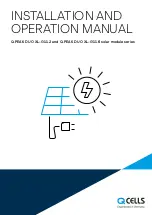
Page
11
Installation Manual 802
SunFrame™ Code-Compliant Planning and Assembly
Material planning for rails and cap strips
Typically, 192-inch standard rail and cap strip lengths will
not match the size of your array.
Preplanning material use
for your particular array can prevent structural or asthetic
problems, particularly those caused by very short lengths of rail
or cap strip.
Stuctural requirements for rails are detailed in “Footing and
splicing requirement” (p. 9). Structurally, cap strips require:
• A screw in every prepunched hole (which occur ev-
ery 16 inches, beginning 8 inches from the ends of
the rails). If it is ever necessary to make a new hole
in a cap strip, drill a 1/4-inch hole before installing
the self-drilling screw.
• One screw no more than 8 inches from the end of
each segment.
For maximum asthetic appeal:
• Cap strip screws on every rail should align (see, for
example, the center line holes in the illustration
below).
• End screws should be equidistant from both sides of
the array.
The example below assumes an array of three rows, each
holding fi ve modules 41 inches wide. Thus, four 205-inch
rail–cap strip assemblies need to be cut and spliced from
192-inch sections of rail and cap strip. The example illus-
trates one means of doing so, which meets all structural and
aesthetic requirements while conserving material.
Rails segments come from fi ve 192-inch lengths, lettered A
thru E. Rail A, for example, is cut into two 96-inch segments,
with one segment spliced into each of the fi rst two rails.
Similarly, fi ve 192-inch cap strips are numbered V through Z.
All cap strip segments are cut at the midpoint between
prepunched screw holes. For each rail, start with the cap
strip segment that crosses the array center line, and align the
appropriate hole with the center line.
Position each cap strip onto its rail and mark its trim point.
Remove and trim before fi nal mounting.
Code compliance note: If your planning sketch shows
that end holes will be more than 8 inches from the ends
of the rails, re-start by aligning a
midpoint between holes
with the array center line.
A 96
″
B 109
″
A 96
″
B 83
″
C 83
″
C 109
″
D 122
″
E 122
″
Array center line
V 112
″
W 112
″
W 80
″
V 80
″
X 96
″
Y 128
″
X 96
″
Z 128
″
Usable remainder: D, 70
″
; E, 70
″
; Y, 64
″
; Z, 64
″
.
4th cap strip
1st rail
3rd cap strip
2nd rail
2nd cap strip
3rd rail
1st cap strip
4th rail
Trim line (array edge)
Trim line (array edge)
Continue the process until all modules in the top row are in
fi nal place and secured from the top. When complete, every
prepunched hole in the cap strip will be secured by a screw,
and the top end of the fi rst row of modules will be secure.
8. Installing the remaining modules row by row
Repeat Steps 6 and 7 for the remaing rows (Fig. 11). Each
subsequent cap strip will secure the tops to the modules being
installed and the bottoms of the modules in the row above.
Place the fi nal cap strip in the lowest rail, securing the bottom
of the lowest module row.
Figure 11. As modules slide into place, the stepping gap shifts,
always allowing access to the section of cap strip being secured.
Secured
1st module
Slide and
secure one
by one
Stepping gap






























